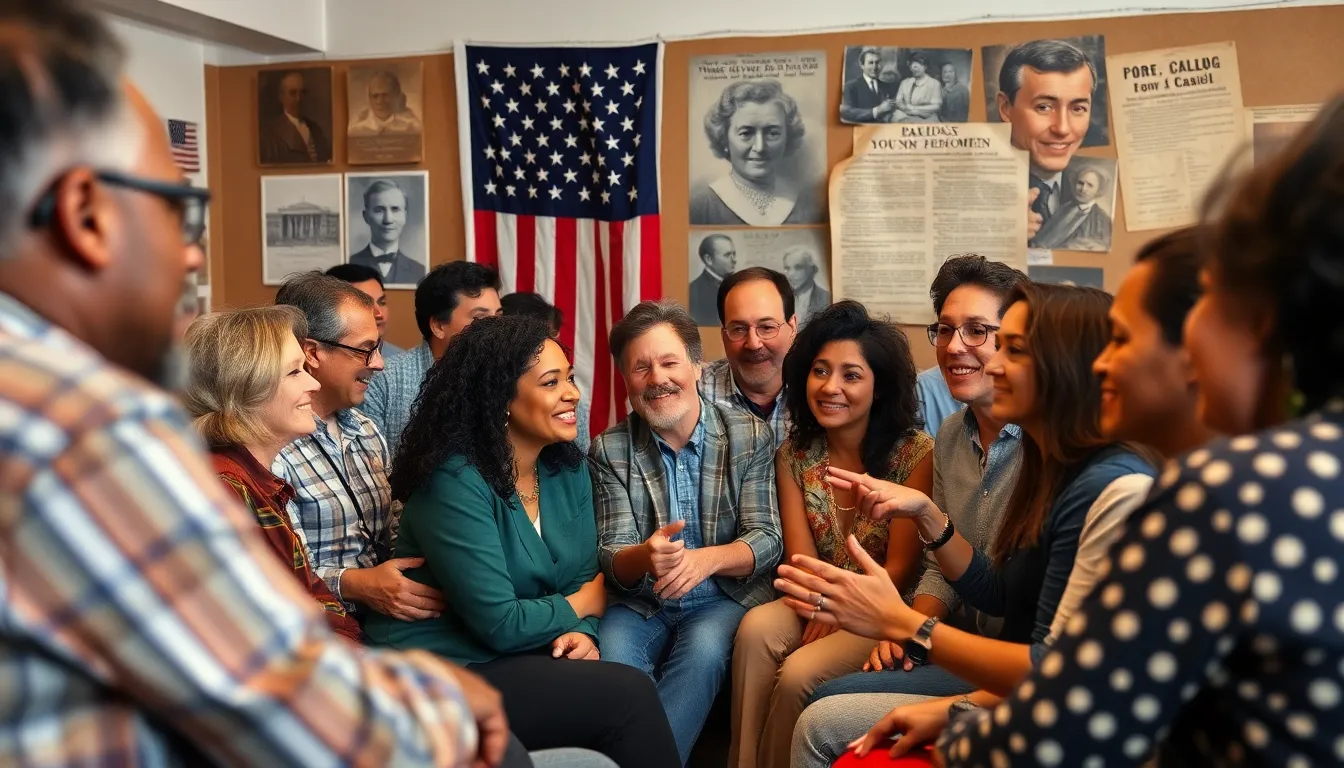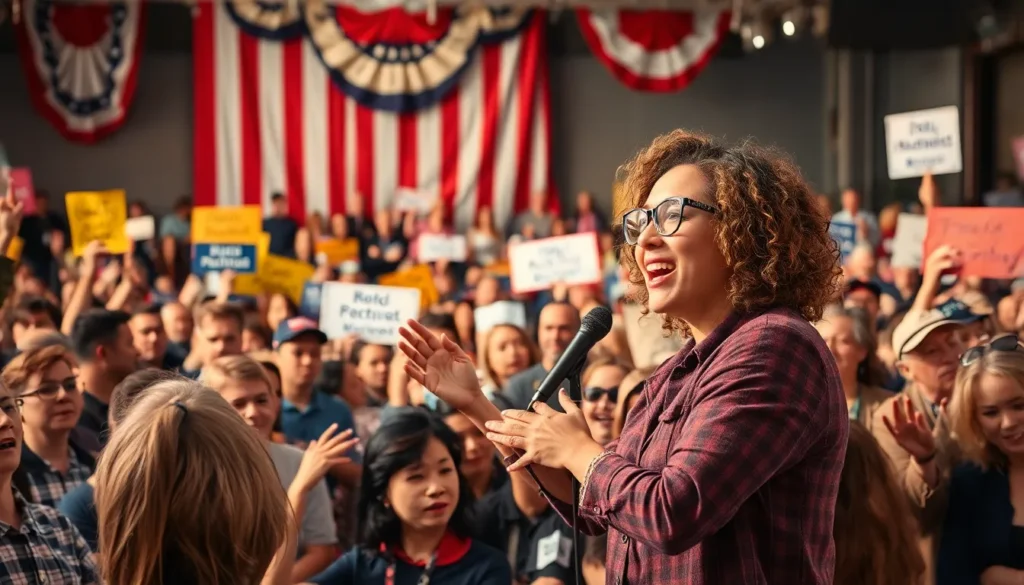In a world where headlines change faster than a politician’s stance, political narratives shape how people perceive their leaders and policies. These stories are the secret sauce behind elections, movements, and even the occasional Twitter storm. Whether it’s a heartwarming tale of a candidate’s humble beginnings or a dramatic showdown of ideologies, the right narrative can turn the tide in an election faster than you can say “fake news.”
Understanding political narratives isn’t just for political junkies—it’s for anyone who wants to navigate the complex landscape of modern politics. With a pinch of humor and a dash of insight, this article dives into how these narratives are crafted, manipulated, and sometimes hilariously backfire. Buckle up for a journey through the art of storytelling in politics, where the truth is often stranger than fiction and the stakes couldn’t be higher.
Table of Contents
ToggleUnderstanding Political Narratives
Political narratives shape public perception and influence political landscapes. Through storytelling, these narratives provide context for leaders and policies, guiding emotions and actions within society.
Definition of Political Narratives
Political narratives consist of stories that convey a specific political message or viewpoint. They frame events and shape the interpretation of political realities. Narratives can include components like historical events, character portrayals, and moral lessons. By constructing these stories, political actors aim to create a cohesive understanding that resonates with the audience. For example, a narrative may highlight a leader’s triumphs to bolster their image while downplaying critical issues.
Importance in Political Discourse
Political narratives play a crucial role in shaping discourse and public opinion. They influence how citizens comprehend issues and their implications for society. Engaging narratives can mobilize communities, turning abstract policies into relatable experiences. Those stories often determine the success of political campaigns as they resonate deeply with voters. Analysis shows that narratives can sway electoral outcomes, demonstrating their power in the political arena. Through effective communication, these narratives sustain engagement, driving movements and discussion.
Historical Context of Political Narratives

Political narratives have long influenced public opinion, shaping perceptions of leaders and policies across eras. Understanding their history provides insights into their current significance.
Evolution Through Time
Political narratives have evolved alongside social and technological changes. Early narratives relied on oral traditions, where leaders used stories to mobilize communities. The advent of printing transformed narrative dissemination, enabling widespread influence through pamphlets and newspapers. With the rise of radio and television, narratives reached a broader audience, crafting national identities. In recent decades, digital platforms have allowed instant sharing and amplification of narratives. This evolution demonstrates the adaptability of political storytelling methods in response to changing communication landscapes.
Case Studies in History
Numerous historical case studies illustrate the power of political narratives. The American Revolution featured narratives about liberty and freedom, rallying colonists against British rule. Similarly, the Civil Rights Movement used compelling stories to highlight injustice, inspiring societal change. More recently, the 2008 presidential campaign of Barack Obama combined hopeful narratives with grassroots mobilization, transforming political engagement. Each case underscores the potency of narratives in shaping public sentiment and political action, illustrating how effective storytelling can drive historical movements.
Components of Political Narratives
Political narratives consist of various components that enhance their effectiveness. They include storytelling techniques and emotional appeals. These elements play a crucial role in shaping public perception and engagement.
Storytelling Techniques
Effective political narratives utilize various storytelling techniques. First, they often involve relatable characters that resonate with audiences. These characters may represent real people or archetypes that symbolize larger societal struggles. Additionally, a clear plot structure typically guides the audience through the narrative, establishing conflict and resolution. Visual imagery also enhances engagement, allowing listeners to visualize scenarios and emotions. Finally, repetition of key themes strengthens retention and encourages participation in political discourse.
Emotional Appeals
Emotional appeals serve as a foundational element in political narratives. Engaging emotions such as hope, fear, and anger can significantly influence public response. Narratives often highlight personal stories, presenting experiences that evoke empathy or solidarity. This tactic fosters connections among community members. Furthermore, political actors leverage emotions to drive urgency, compelling people to take action or support specific policies. Ultimately, effective emotional appeals transform abstract political concepts into relatable human experiences, prompting deeper engagement and commitment.
The Role of Media in Shaping Political Narratives
Media significantly influences political narratives, framing public perception and discourse. Both traditional and social media play critical roles in how narratives unfold.
Traditional Media Influence
Traditional media channels such as newspapers, television, and radio have long shaped political narratives. These platforms curate content, guiding focus towards particular issues and promoting specific angles. Sourcing from journalists, reports often highlight certain events over others, generating public discourse around these select moments. Coverage shapes opinions by emphasizing particular narratives, from election campaigns to policy debates. Power dynamics in media ownership also affect which stories receive attention, ultimately influencing political outcomes. Audiences often trust established outlets, giving these narratives additional weight.
Social Media Impact
Social media has transformed how political narratives spread in recent years. Platforms like Twitter, Facebook, and Instagram allow individuals to share opinions rapidly. This immediacy creates an environment where narratives evolve quickly, often shaped by user engagement. Viral posts can amplify particular messages, leading to widespread public reaction. Users actively participate by commenting, sharing, and creating content, further influencing the conversation. Algorithms prioritize content that resonates emotionally, guiding political discourse in real-time. Consequently, social media offers a dual-edged sword, allowing for grassroots movements while also enabling misinformation to flourish.
Current Trends in Political Narratives
Political narratives are evolving rapidly, shaped largely by current societal factors. With the rise of social media and divergent media landscapes, narratives reflect deeper divides in society.
Polarization and Division
Polarization has intensified within political narratives, leading to more contentious public discourse. Divisive rhetoric increasingly characterizes campaigns and policies, often encouraging supporters to adopt extreme positions. Heightened emotions shape interactions, creating echo chambers where individuals only engage with similar viewpoints. As a result, fringe ideas gain visibility, impacting mainstream discussions. Accusations and counter-narratives amplify this division further, complicating consensus-building. This trend indicates that stories are not only about messaging but also about reinforcing group identities, making it challenging to navigate political conversations across differing belief systems.
Globalization of Political Narratives
Globalization brings new dimensions to political narratives, enabling stories to transcend borders and cultures. Diverse voices now influence political debate, broadening perspectives and changing local dynamics. Information spreads rapidly across platforms, allowing citizens to engage with narratives from around the world. Foreign events often inspire local movements, as seen in various social justice campaigns. Increased interconnectedness fosters both empathy and competition, challenging traditional narratives while forming new alliances. This shift emphasizes the importance of understanding global contexts in national political discourses, highlighting that local narratives often reflect broader global trends.
Political narratives wield immense power in shaping public opinion and driving social change. They turn complex policies into relatable stories that resonate deeply with individuals. As society continues to evolve with technology and globalization, these narratives will adapt, reflecting new realities and challenges.
Understanding the dynamics of political storytelling is crucial for both leaders and citizens. Engaging narratives can mobilize communities and inspire action, while also highlighting the importance of critical thinking in a media-saturated world. As political landscapes shift, the stories told will remain central to the ongoing dialogue about governance and society.





